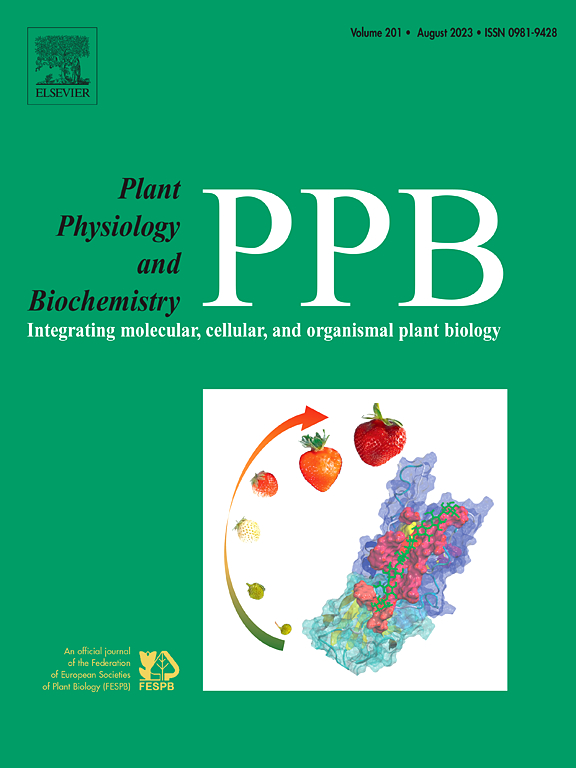强光胁迫对毛缕凤蝶生理和转录组的影响
IF 6.1
2区 生物学
Q1 PLANT SCIENCES
引用次数: 0
摘要
毛角紫菜(Pterocladiella capillacea)是一种富含生物活性化合物的亚热带红藻,具有重要的医药价值,广泛分布于潮间带和潮下带的岩礁中。然而,由于气候变化和人为活动,该物种的天然生物量不断减少,给水产养殖和商业开发带来了挑战。强光胁迫是影响其生长和繁殖的一个关键环境因素,但对其潜在的分子机制仍然知之甚少。本研究探讨了高光胁迫对湛江鳌洲岛毛鳞鱼叶绿素荧光参数、生理指标和转录组的影响。结果表明,高光胁迫对叶绿素荧光参数、光合速率、光合色素生物合成、丙二醛含量、抗氧化酶活性和渗透溶质积累都有明显的干扰。转录组分析发现,在 120 μmol m-2s-1、300 μmol m-2s-1 和 500 μmol m-2s-1 处理下,分别有 2281、7640 和 8800 个差异表达基因(DEGs)。功能富集分析(GO 和 KEGG)突出显示了主要参与光合作用、抗氧化系统、蔗糖/淀粉代谢和叶绿素生物合成的 DEGs。时间表达模式分析进一步发现了与光照强度增加相关的五种不同的基因表达趋势。这些发现为毛鳞藻耐强光的生理和分子机制提供了新的见解,为未来分子育种计划提供了理论基础,以提高这种具有重要经济价值的藻类的抗逆性。本文章由计算机程序翻译,如有差异,请以英文原文为准。

The impact of high-light stress on the physiology and transcriptome of Pterocladiella capillacea
Pterocladiella capillacea, a subtropical red alga rich in bioactive compounds, holds significant pharmaceutical value and is widely distributed in intertidal and subtidal rocky reefs. However, the natural biomass of this species declines due to climate change and anthropogenic activities, posing challenges to its aquaculture and commercial exploitation. High-light stress represents a critical environmental factor affecting its growth and reproduction, yet the underlying molecular mechanisms remain poorly understood. This study investigates the effects of high-light stress on chlorophyll fluorescence parameters, physiological indices, and transcriptomic profiles of P. capillacea collected from Naozhou Island, Zhanjiang. Results reveal that high-light stress significantly perturbs chlorophyll fluorescence parameters, photosynthetic rates, photosynthetic pigment biosynthesis, malondialdehyde content, antioxidant enzyme activities, and osmolyte accumulation. The transcriptomic analysis identifies 2,281, 7,640, and 8800 differentially expressed genes (DEGs) under 120 μmol m−2s−1, 300 μmol m−2s−1, and 500 μmol m−2s−1 treatments, respectively. Functional enrichment analysis (GO and KEGG) highlighted DEGs primarily involved in photosynthesis, antioxidant systems, sucrose/starch metabolism, and chlorophyll biosynthesis. Temporal expression pattern analysis further uncovered five distinct gene expression trends associated with increasing light intensity. These findings provide novel insights into the physiological and molecular mechanisms underlying high-light tolerance in P. capillacea, offering a theoretical foundation for future molecular breeding programs to improve stress resilience in this economically important alga.
求助全文
通过发布文献求助,成功后即可免费获取论文全文。
去求助
来源期刊
CiteScore
11.10
自引率
3.10%
发文量
410
审稿时长
33 days
期刊介绍:
Plant Physiology and Biochemistry publishes original theoretical, experimental and technical contributions in the various fields of plant physiology (biochemistry, physiology, structure, genetics, plant-microbe interactions, etc.) at diverse levels of integration (molecular, subcellular, cellular, organ, whole plant, environmental). Opinions expressed in the journal are the sole responsibility of the authors and publication does not imply the editors'' agreement.
Manuscripts describing molecular-genetic and/or gene expression data that are not integrated with biochemical analysis and/or actual measurements of plant physiological processes are not suitable for PPB. Also "Omics" studies (transcriptomics, proteomics, metabolomics, etc.) reporting descriptive analysis without an element of functional validation assays, will not be considered. Similarly, applied agronomic or phytochemical studies that generate no new, fundamental insights in plant physiological and/or biochemical processes are not suitable for publication in PPB.
Plant Physiology and Biochemistry publishes several types of articles: Reviews, Papers and Short Papers. Articles for Reviews are either invited by the editor or proposed by the authors for the editor''s prior agreement. Reviews should not exceed 40 typewritten pages and Short Papers no more than approximately 8 typewritten pages. The fundamental character of Plant Physiology and Biochemistry remains that of a journal for original results.

 求助内容:
求助内容: 应助结果提醒方式:
应助结果提醒方式:


